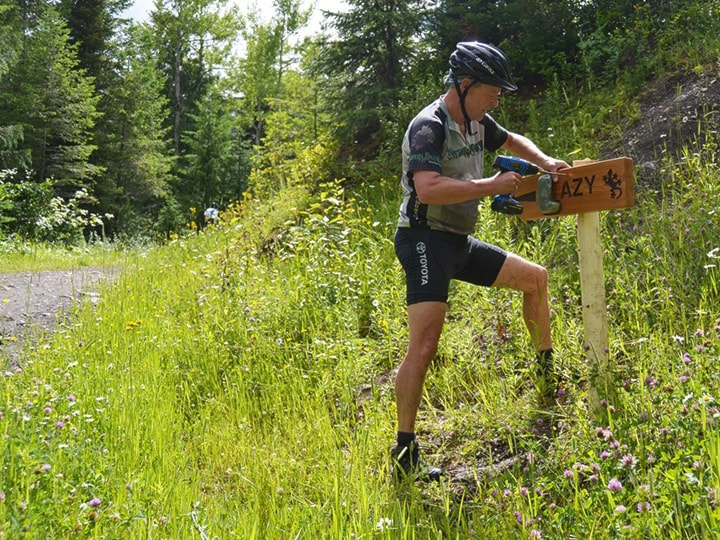For years, Fernie’s hike and bike trails have been adorned with creative handcrafted wooden signage, and while they only serve to fill the gaps between the metal signage that the Fernie Trails Alliance (FTA) posts they have become a welcomed addition to the nameplate network.
Recent signs are more than likely the work of Robert Champagne, an avid cyclist who was looking for a way to combine creativity and woodwork with his passion for cycling. Champagne says that it all started at the split on the Hyper Ventilation climb in the Montane trail network.
“As I was climbing to Hypervent, there was an unmarked junction that split between the easy and hard way up. I thought it would be a good idea to put a sign up to tell people what way would be easier and more difficult,” said Champagne. “As it turned out I was speaking to someone who had been living here a long time and they said ‘whenever we hike up that trail we never know what way to go at the junction, but we always find our way to the top.’ Little did they realise that the two trails came together, it is not obvious at the top or anything.”

Fernie was not the first area to see Champagne’s sign work.
“I made my first signs in Manitoba. When I look back at those I think ‘oh my’ the workmanship has grown to be so much better. I just made the first ones up real quick I’m now way more picky and proud of what I am putting up,” he said.
While he started making signs in Manitoba, motivation for signs here came from Fernie local Doug Koran.
“He was my inspiration in a sense. The signs that were here before were what inspired me to make more. I always loved those signs. I just wanted to keep up the tradition of something other than the stock metal signage, and everyone loves the wood signs,” said Champagne..
Koran believes that the signs are in good hands and has not made any signs recently.
“Robert is doing a really good job with them and has kicked it up a notch, he definitely spends more time at it then I did. It is all looking good,” he said.
Both woodworkers had the same reasons for starting – to help people find their way in the woods. With multiple trails and networks surrounding Fernie, their signs help hikers and bikers make sense of the local trails.
Despite the time he puts into the signs, Champagne only makes signs for fun and still wants to get out and ride his bike.
“It’s a real creative outlet for me, I really think it is fun to take an idea and make a sign out of it. That’s my favourite, when I come up with something or I am asked to do something,” he said. “I would rather not be asked to make one, I do not want to get into having commitments – I am just doing it for fun. I don’t want to get to the point where it’s not fun.”
The lifetime of a sign can vary depending on the wood and if varnish, or finish, has been applied to the sign.
“I was doing them all on non-cedar at first, and put three coats of varnish on them. Then I got into the cedar because I was given some to make signs with and I was told to not bother putting finish on them, but I don’t like how they weather without the finish so I will definitely, from now on, be giving every sign three coats,” said Champagne. “Some of Doug Koran’s signs that he made years ago are varnished well and are still holding out after all these years.”
Some of the signs that Koran made that are not on the trails, like the sign for the trail Snake Bite can be found in the The Fernie Hotel.
Champagne’s signs were not always so welcomed he said. His first sign that marked the easy and hard way to climb Hyper Ventilation came with some criticism.
“I made up that sign and got some flack from some of the locals and trail people. Even though I was on the trails committee at this time, they were saying ‘we don’t need more signs, we had to learn the trails ourselves so others should too.’ And my argument was, when I go out somewhere for a few days I do not want to learn a trail system. I want to ride,” he said. “It took several months before people started adapting to the idea that we need more signage. I was only filling in the gaps, now people seem to love them.”
